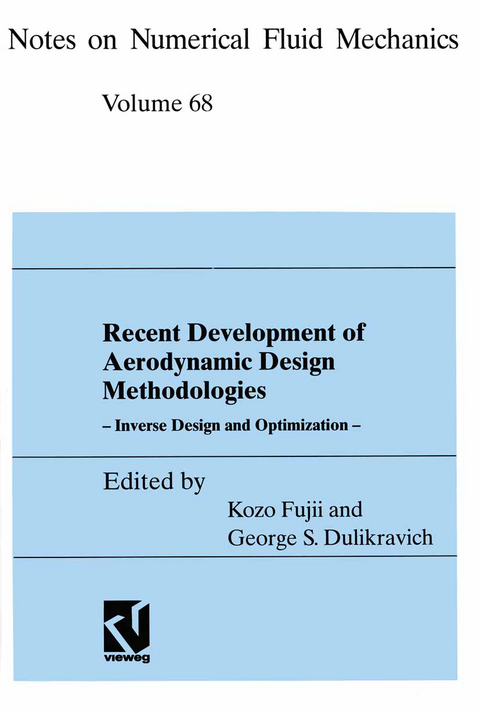
Recent Development of Aerodynamic Design Methodologies
Inverse Design and Optimization
Seiten
2013
|
1. Softcover reprint of the original 1st ed. 1999
Vieweg & Teubner (Verlag)
978-3-322-89954-5 (ISBN)
Vieweg & Teubner (Verlag)
978-3-322-89954-5 (ISBN)
Aktuelle Forschungsergebnisse
Computational Fluid Dynamics (CFD) has made remarkable progress in the last two decades and is becoming an important, if not inevitable, analytical tool for both fundamental and practical fluid dynamics research. The analysis of flow fields is important in the sense that it improves the researcher's understanding of the flow features. CFD analysis also indirectly helps the design of new aircraft and/or spacecraft. However, design methodologies are the real need for the development of aircraft or spacecraft. They directly contribute to the design process and can significantly shorten the design cycle. Although quite a few publications have been written on this subject, most of the methods proposed were not used in practice in the past due to an immature research level and restrictions due to the inadequate computing capabilities. With the progress of high-speed computers, the time has come for such methods to be used practically. There is strong evidence of a growing interest in the development and use of aerodynamic inverse design and optimization techniques. This is true, not only for aerospace industries, but also for any industries requiring fluid dynamic design. This clearly shows the matured engineering need for optimum aerodynamic shape design methodologies. Therefore, it seems timely to publish a book in which eminent researchers in this area can elaborate on their research efforts and discuss it in conjunction with other efforts.
Computational Fluid Dynamics (CFD) has made remarkable progress in the last two decades and is becoming an important, if not inevitable, analytical tool for both fundamental and practical fluid dynamics research. The analysis of flow fields is important in the sense that it improves the researcher's understanding of the flow features. CFD analysis also indirectly helps the design of new aircraft and/or spacecraft. However, design methodologies are the real need for the development of aircraft or spacecraft. They directly contribute to the design process and can significantly shorten the design cycle. Although quite a few publications have been written on this subject, most of the methods proposed were not used in practice in the past due to an immature research level and restrictions due to the inadequate computing capabilities. With the progress of high-speed computers, the time has come for such methods to be used practically. There is strong evidence of a growing interest in the development and use of aerodynamic inverse design and optimization techniques. This is true, not only for aerospace industries, but also for any industries requiring fluid dynamic design. This clearly shows the matured engineering need for optimum aerodynamic shape design methodologies. Therefore, it seems timely to publish a book in which eminent researchers in this area can elaborate on their research efforts and discuss it in conjunction with other efforts.
Multi Objective Aerodynamic Optimisation by Means of Robust and Efficient Genetic Algorithm.- Inverse Optimization Method for Aerodynamic Shape Design.- Subsonic Aerodynamic Design via Shape Optimization.- Parametric Airfoils and Wings.- Using Existing Flow-Field Analysis Codes for Inverse Design of Three-Dimensional Aerodynamic Shapes.- Numerical Methods for Inverse Solution in Aerodynamic Design of Turbomachinery.- Inverse Blade Design Based on Permeable Wall Concept.- An Inverse Design Method for Wings Using Integral Equaitons and Its Recent Progress.- Application of Transonic Inverse Method to the Development of Aerospace Products.- Aerodynamic Design of Wing-Engine Configuration under Effect of Jet Plume.
| Erscheint lt. Verlag | 13.11.2013 |
|---|---|
| Reihe/Serie | Notes on Numerical Fluid Mechanics |
| Zusatzinfo | XI, 221 p. 161 illus. |
| Verlagsort | Wiesbaden |
| Sprache | englisch |
| Maße | 155 x 235 mm |
| Gewicht | 338 g |
| Themenwelt | Naturwissenschaften ► Physik / Astronomie ► Mechanik |
| Naturwissenschaften ► Physik / Astronomie ► Strömungsmechanik | |
| Technik ► Luft- / Raumfahrttechnik | |
| Schlagworte | computational fluid dynamics • Computer • Dynamics • flow • fluid- and aerodynamics • Fluid Dynamics • fluid mechanics • Numerics • Numerik • Strömung • Strömungsmechanik |
| ISBN-10 | 3-322-89954-3 / 3322899543 |
| ISBN-13 | 978-3-322-89954-5 / 9783322899545 |
| Zustand | Neuware |
| Haben Sie eine Frage zum Produkt? |
Mehr entdecken
aus dem Bereich
aus dem Bereich
Statik - Kinematik - Kinetik - Schwingungen - Festigkeitslehre
Buch | Hardcover (2021)
Hanser, Carl (Verlag)
CHF 41,95


